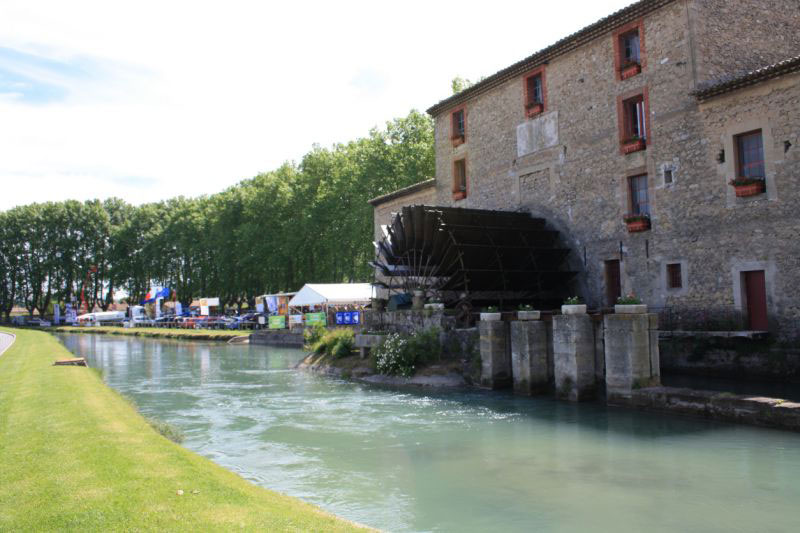La roue
Certainement la plus grande du département, elle a un diamètre de 8m, sa largeur est de 6m et elle est composée de 24 aubes. Actuellement, elle tourne toujours sous l’action des eaux du canal mais sa fonction se résume à moudre le temps qui passe. Elle reste cependant le symbole du passé industriel du village.
L’engrenage
« La mémoire du Moulin », c’est ainsi qu’on pourrait nommer l’engrenage placé au centre du rond point non loin du moulin.
Cette superbe roue dentée (de 3.30m de diamètre, 0.23m d’épaisseur et pesant 4T) est en effet l’entraînement primaire du jeu d’engrenages existant toujours dans le sous-sol du moulin.
Ce jeu permettait, par la démultiplication acquise, d’accélérer la vitesse de rotation des meules pour un broyage efficace.
Cet engrenage est la copie conforme de l’original datant de 1850 détérioré par le gel du terrible hiver de 1956 mais dont le moule d’origine avait été conservé dans une fonderie de Saint-Dié (Vosges).
Cette roue, au chômage depuis 1970, a trouvé le lieu qui lui redonne tout son éclat perdu et devient ainsi « la Mémoire du Moulin ».
L’activité du moulin Saint-Pierre débute au mois de novembre 1859, lorsque s’ouvre le canal de l’Isle. Tout d’abord moulin à garance (plante tinctoriale dont on extrayait à partir de sa racine, une poudre rouge, l’alizarine, mais dont la production fut de courte durée car concurrencée par le marché des produits de synthèse), ce bâtiment est vendu aux enchères en 1867. Il passera dans plusieurs mains et restera inactif.
Il faut attendre l’année 1874 pour que deux minotiers des Taillades le rachètent. Le moulin connaît alors une nouvelle utilisation et devient moulin à farine jusqu’en 1881.
Le syndicat du canal l’achète le 28 décembre 1891. En 1894, un premier bail est établi avec Monsieur Jean Baptiste Blanc, meunier de métier. Suivent ensuite d’autres baux signés avec cette même famille Blanc des Taillades et ce, jusqu’en 1970, date à laquelle cesse l’activité du moulin à farine. Pendant quelques années les locaux seront loués à des usagers divers. Et le 29 octobre 1981, la municipalité des Taillades achète le moulin au syndicat du canal.
Celle-ci transforme une partie des bâtiments en salle des fêtes, salles de réunions, de sports, ateliers pour le personnel technique et une aile est louée à une société.
Depuis quelques années, durant l’été, ont lieu dans la Cour des manifestations culturelles (théâtre, musique …) qui ont conquis un large public.

Saint Peter’s Mill
The mill is closely linked to the canal which flows past it.
It was in fact the construction of the Canal de l’Isle that led Mr Derrive, a businessman, to build a factory for processing madder. This plant, with its tinctorial properties (the red dye extracted from its roots) ensured the economic and agricultural prosperity of Vaucluse, which experienced a golden age based on the colour red. It was in November 1859 that Mr Derrive received permission « to divert the waters of the canal to power the water-wheel of his factory ». However, this activity began to decline from 1868 onwards. In 1867, the mill had been sold by auction and then frequently changed hands.
In 1874, two millers from Les Taillades purchased the mill, converted it into a flour mill and kept it until 1881. After belonging to other owners, the mill passed to the Syndicat du Canal Mixte (the association operating the canal) in 1891. This association rented it to the Blanc family from 1894 to 1970, at which time flour milling ceased. The premises were then rented to various users. On 29 October 1981, the municipality of Les Taillades finally bought the mill from the Syndicat and converted part of the buildings into the village hall, meeting rooms, sports facilities and workshops for the roads department, while one wing was let to a private firm.
For some years, cultural events (theatre, music, etc.) have been held in the courtyard during the summer and have attracted a large following.
The wheel and its functions
This paddle wheel used the energy provided by the water flowing through the canal to operate the millstones. The water arrived via the headrace fitted with a set of gate valves which controlled the water flow according to requirements. The head thus created could power the wheel at the chosen rate. The water leaving the mill returned to the canal through the tailrace. The movement of the wheel rotated a central shaft, which operated a sequence of gears increasing the speed to turn the millstones. The wheel is nowadays running idle and is the symbol of the village’s industrial past.
It is 8 m in diameter, 6 m in width and comprises 24 blades.
The avenue of plane trees
The majestic avenue of plane trees contributes to the overall impression of the building, both as a decorative element and as an architectural feature providing the desired perspective.
The gear transmission room and the pitwheel
The cogged wheel displayed at the centre of the roundabout at the entrance to the village was the pitwheel, which connected directly with the paddle wheel and was the first stage of the train of gears in the transmission room. The gearing mechanism steps up the speed of rotation to work the grindstones: the stationary bedstone and the moving runner stone. The bedstone was fixed on a base. The runner stone was placed above it and rotated, driven by the central shaft. The grain was crushed between the two stones. During the disastrous winter of 1956, the pitwheel dating from 1859 was damaged by frost.
Fortunately, the original mould had been kept at the foundry in Saint-Dié in the Vosges, so that an
identical copy could be made. This cogged wheel is 3.30 m in diameter, 0.23 m thick and weighs four tons. It has thus become « the Memory of the Mill ».